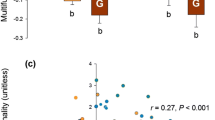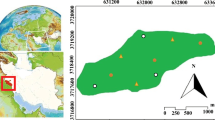Abstract
Aims
Current studies on the relationship between biodiversity and ecosystem functioning have mostly focused on plant communities. Less is known about the individual and combined effects of biodiversity components above-and-below-ground on ecosystem multifunctionality. The aim of this study was to explore how different management regimes influence multifunctionality via modification of both plant and soil microbial (bacterial and fungal) diversity.
Methods
We used a 6-year experiment in Inner Mongolian grassland to compare multifunctionality and separate functions related to the C, N, P cycles and plant productivity under four management regimes and examine relationships between these functions and different components of biodiversity, both above- and belowground.
Results
Ecosystem multifunctionality and the rates of nutrient cycling and plant productivity, were greatest under moderate grazing intensity, and lowest under no grazing. Further, across all management regimes, multifunctionality was positively related to plant diversity, and plant and soil microbial diversity combined explained a much greater (62.5%) proportion of variance in multifunctionality than that did either component alone. Different components of biodiversity showed contrasting relationships with individual functions: plant diversity was positively related to C and N cycling, whereas bacterial diversity was negatively related to P cycling and plant productivity.
Conclusions
Moderate grazing has better outcomes for biodiversity conservation and ecosystem multifunctionality than mowing and cessation of grazing. Sustainable grazing management is a viable strategy to conserve both above- and belowground biodiversity and enhance the delivery of multiple ecosystem functions.




Similar content being viewed by others
References
Allan E, Manning P, Alt F, Binkenstein J, Blaser S, Blüthgen N, Böhm S, Grassein F, Hölzel N, Klaus VH (2015) Land use intensification alters ecosystem multifunctionality via loss of biodiversity and changes to functional composition. Ecol Lett 18:834–843
Bai Y, Wu J, Pan Q, Huang J, Wang Q, Fusheng LI, Alexander B, Han X (2007) Positive linear relationship between productivity and diversity: evidence from the Eurasian steppe. J Appl Ecol 44:1023–1034
Baoyin T, Li FY, Bao Q, Minggagud H, Zhong Y (2014) Effects of mowing regimes and climate variability on hay production of Leymus chinensis (Trin.) Tzvelev grassland in northern China. Rangel J 36:593–600
Bardgett RD, Streeter TC, Bol R (2003) Soil microbes compete effectively with plants for organic-nitrogen inputs to temperate grasslands. Ecology 84:1277–1287
Bardgett RD, van der Putten WH (2014) Belowground biodiversity and ecosystem functioning. Nature 515:505–511
Bardgett RD, Wardle DA (2003) Herbivore-mediated linkages between aboveground and belowground communities. Ecology 84:2258–2268
Bell TH, Callender KL, Whyte LG, Greer CW (2013) Microbial competition in polar soils: a review of an understudied but potentially important control on productivity. Biology 2:533–554
Bradford MA, Wood SA, Bardgett RD, Black HI, Bonkowski M, Eggers T, Grayston SJ, Kandeler E, Manning P, Setälä H (2014) Discontinuity in the responses of ecosystem processes and multifunctionality to altered soil community composition. Proc Natl Acad Sci U S A 111:14478–14483
Byrnes JEK, Gamfeldt L, Isbell F, Lefcheck JS, Griffin JN, Hector A, Cardinale BJ, Hooper DU, Dee LE, Duffy JE (2014) Investigating the relationship between biodiversity and ecosystem multifunctionality: challenges and solutions. Methods Ecol Evol 5:111–124
Cairney JWG (2005) Basidiomycetes mycelia in forest soils: dimensions, dynamics and roles in nutrient distribution. Mycol Res 109:7–20
Cardinale BJ, Duffy JE, Gonzalez A, Hooper DU, Perrings C, Venail P, Narwani A, Mace GM, Tilman D, Wardle DA, Kinzig AP, Daily GC, Loreau M, Grace JB, Larigauderie A, Srivastava DS, Naeem S (2012) Biodiversity loss and its impact on humanity. Nature 486:59–67
Carrera AL, Bertiller MB, Larreguy C (2008) Leaf litterfall, fine-root production, and decomposition in shrublands with different canopy structure induced by grazing in the Patagonian Monte, Argentina. Plant Soil 311:39–50
Catorci A, Cesaretti S, Malatesta L, Tardella FM (2014) Effects of grazing vs mowing on the functional diversity of sub-Mediterranean productive grasslands. Appl Veg Sci 17:658–669
Chillo V, Ojeda RA, Capmourteres V, Anand M (2016) Functional diversity loss with increasing livestock grazing intensity in drylands: the mechanisms and their consequences depend on the taxa. J Appl Ecol 54:986–996
de Mazancourt C, Loreau M, Abbadie L (1999) Grazing optimization and nutrient cycling: potential impact of large herbivores in a savanna system. Ecol Appl 9:784–797
de Vries FT, Thébault E, Liiri M, Birkhofer K, Tsiafouli MA, Bjørnlund L, Jørgensen HB, Brady MV, Christensen S, de Ruiter PC, Bardgett RD (2013) Soil food web properties explain ecosystem services across European land use systems. Proc Natl Acad Sci U S A 110:14296–14301
Delgado-Baquerizo M, Eldridge DJ, Ochoa V, Gozalo B, Singh BK, Maestre FT (2017) Soil microbial communities drive the resistance of ecosystem multifunctionality to global change in drylands across the globe. Ecol Lett 20:1295–1305
Delgado-Baquerizo M, Maestre FT, Reich PB, Jeffries TC, Gaitan JJ, Daniel E, Miguel B, Campbell CD, Singh BK (2016) Microbial diversity drives multifunctionality in terrestrial ecosystems. Nat Commun 7:1–8
Dighton J (2007) Nutrient cycling by saprotrophic fungi in terrestrial habitats. In: Kubicek CP, Druzhinina IS (eds) The Mycota IV environmental and microbial relationships. Springer Berlin Heidelberg, New York, pp 287–300
Finzi AC, Berthrong ST (2005) The uptake of amino acids by microbes and trees in three cold-temperate forests. Ecology 86:3345–3353
Grime JP (1997) Biodiversity and ecosystem function: the debate deepens. Science 277:1260–1261
Harris D, Horwáth WR, Kessel CV (2001) Acid fumigation of soils to remove carbonates prior to Total organic carbon or Carbon-13 isotopic analysis. Soil Sci Soc Am J 65:1853–1856
Hayashi M, Fujita N, Yamauchi A (2007) Theory of grazing optimization in which herbivory improves photosynthetic ability. J Theor Biol 248:367–376
Hector A, Bagchi R (2007) Biodiversity and ecosystem multifunctionality. Nature 448:188–190
Hector A, Hooper R (2002) Darwin and the first ecological experiment. Science 295:639–640
Holden SR, Gutierrez A, Treseder KK (2013) Changes in soil fungal communities, extracellular enzyme activities, and litter decomposition across a fire chronosequence in Alaskan boreal forests. Ecosystems 16:34–46
Hossain MZ, Sugiyama SI (2010) Effects of chemical composition on the rate and temporal pattern of decomposition in grassland species leaf litter. Grassl Sci 54:40–44
Jing X, Sanders NJ, Shi Y, Chu H, Classen AT, Zhao K, Chen L, Shi Y, Jiang Y, He JS (2015) The links between ecosystem multifunctionality and above- and belowground biodiversity are mediated by climate. Nat Commun 6:8159–8166
Kohler F, Hamelin J, Gillet F, Gobat JM, Buttler A (2005) Soil microbial community changes in wooded mountain pastures due to simulated effects of cattle grazing. Plant Soil 278:327–340
Letts B, Lamb EG, Mischkolz JM, Romo JT (2015) Litter accumulation drives grassland plant community composition and functional diversity via leaf traits. Plant Ecol 216:357–370
Li Y, Wang W, Liu Z, Jiang S (2008) Grazing gradient versus restoration succession of Leymus chinensis (Trin.) Tzvel. Grassland in Inner Mongolia. Restor Ecol 16:572–583
Maestre FT, Quero JL, Gotelli NJ, Escudero A, Ochoa V, Delgado-Baquerizo M, García-Gómez M, Bowker MA, Soliveres S, Escolar C, Zaady E (2012) Plant species richness and ecosystem multifunctionality in global drylands. Science 335:214–218
Manning P, van der Plas F, Soliveres S, Allan E, Maestre FT, Mace G, Whittingham MJ, Fischer M (2018) Redefining ecosystem multifunctionality. Nat Ecol Evol 2:427–436
Mayfield MM, Bonser SP, Morgan JW, Aubin I, Mcnamara S, Vesk PA (2010) What does species richness tell us about functional trait diversity? Predictions and evidence for responses of species and functional trait diversity to land-use change. Glob Ecol Biogeogr 19:423–431
Mittelbach GG, Steiner CF, Scheiner SM, Gross KL, Reynolds HL, Waide RB, Willig MR, Dodson SI, Gough L (2001) What is the observed relationship between species richness and productivity? Ecology 82:2381–2396
Naeem S (2002) Ecosystem consequences of biodiversity loss: the evolution of a paradigm. Ecology 83:1537–1552
Nakagawa S, Schielzeth H (2013) A general and simple method for obtaining R2 from generalized linear mixed-effects models. Methods Ecol Evol 4:133–142
Nordin A, Schmidt IK, Shaver GR (2004) Nitrogen uptake by arctic soil microbes and plants in relation to soil nitrogen supply. Ecology 85:955–962
Pasari JR, Levi T, Zavaleta ES, Tilman D (2013) Several scales of biodiversity affect ecosystem multifunctionality. Proc Natl Acad Sci U S A 110:10219–10222
Pereira HM, Navarro LM, Martins IS (2012) Global biodiversity change: the bad, the good, and the unknown. Annu Rev Environ Resour 37:25–50
Raich JW, Schlesinger WH (1992) The global carbon dioxide flux in soil respiration and its relationship to vegetation and climate. Tellus B 44:81–99
Reid WV, Watson RT, Rosswall T, Steiner A, Töpfer K, Arico S, Bridgewater P (2005) Millennium ecosystem assessment: ecosystems and human well being– synthesis report
R Core Development Team (2016) R: a language and environment for statistical computing. R Foundation for Statistical Computing, Vienna. http://www.R-project.org. Accessed 22 July 2019
Roesch LFW, Fulthorpe RR, Riva A, Casella G, Hadwin AKM, Kent AD, Daroub SH, Camargo FAO, Farmerie WG, Triplett EW (2007) Pyrosequencing enumerates and contrasts soil microbial diversity. ISME J 1:283–290
Scherer-Lorenzen M, Palmborg C, Prinz A, Schulze ED (2003) The role of plant diversity and composition for nitrate leaching in grasslands. Ecology 84:1539–1552
Schmidt IK, Michelsen A, Jonasson S (1997) Effects of labile soil carbon on nutrient partitioning between an arctic graminoid and microbes. Oecologia 112:557–565
Seidel D, Leuschner C, Scherber C, Beyer F, Wommelsdorf T, Cashman MJ, Fehrmann L (2013) The relationship between tree species richness, canopy space exploration and productivity in a temperate broad-leaf mixed forest. Forest Ecol Manag 310:366–374
Shan Y, Chen D, Guan X, Zheng S, Chen H, Wang M, Bai Y (2011) Seasonally dependent impacts of grazing on soil nitrogen mineralization and linkages to ecosystem functioning in Inner Mongolia grassland. Soil Biol Biochem 43:1943–1954
Valencia E, Maestre FT, Le BPY, Quero JL, Tamme R, Börger L, Garcíagómez M, Gross N (2015) Functional diversity enhances the resistance of ecosystem multifunctionality to aridity in Mediterranean drylands. New Phytol 206:660–671
van der Heijden MGA, Bardgett RD, van Straalen NM (2008) The unseen majority: soil microbes as drivers of plant diversity and productivity in terrestrial ecosystems. Ecol Lett 11:296–310
Wagg C, Bender SF, Widmer F, van der Heijden MGA (2014) Soil biodiversity and soil community composition determine ecosystem multifunctionality. Proc Natl Acad Sci U S A 111:5266–5270
Walter J, Hein R, Beierkuhnlein C, Hammerl V, Jentsch A, Schädler M, Schuerings J, Kreyling J (2013) Combined effects of multifactor climate change and land-use on decomposition in temperate grassland. Soil Biol Biochem 60:10–18
Wan Z, Yang J, Gu R, Liang Y, Yan Y, Gao Q, Yang J (2016) Influence of different mowing systems on community characteristics and the compensatory growth of important species of the Stipa grandis steppe in Inner Mongolia. Sustainability 8:1121–1131
Wardle DA, Bardgett RD, Klironomos JN, Setälä H, Wh VDP, Wall DH (2004) Ecological linkages between aboveground and belowground biota. Science 304:1629–1633
Yang Y, Wu L, Lin Q, Yuan M, Xu D, Yu H, Hu Y, Duan J, Li X, He Z (2013) Responses of the functional structure of soil microbial community to livestock grazing in the Tibetan alpine grassland. Glob Chang Biol 19:637–648
Zavaleta ES, Pasari JR, Hulvey KB, Tilman GD (2010) Sustaining multiple ecosystem functions in grassland communities requires higher biodiversity. Proc Natl Acad Sci U S A 107:1443–1446
Zou YL, Niu DC, Fu H, Zhang YC, Wan CG (2015) Moderate grazing promotes ecosystem carbon sequestration in an Alpine meadow on the Qinghai-Tibetan plateau. J Anim Plant Sci 25:165–171
Acknowledgements
The research was supported by the Ministry of Science and Technology of China (Grant No.2016YFC0500508; 2015BAC02B04; 2014CB138805) and the Department of Science and Technology of Inner Mongolia Autonomous Region of China (Grant for Key Basic Research on Grassland Ecosystems). RDB was supported by BBSRC GCRF grant (BB/P022987/1) “Restoring soil function and resilience to degraded grasslands”.
Author information
Authors and Affiliations
Corresponding author
Additional information
Responsible Editor: Feike A. Dijkstra.
Publisher’s note
Springer Nature remains neutral with regard to jurisdictional claims in published maps and institutional affiliations.
Electronic supplementary material
ESM 1
(DOCX 1889 kb)
Rights and permissions
About this article
Cite this article
Wang, X., Li, F.Y., Wang, Y. et al. High ecosystem multifunctionality under moderate grazing is associated with high plant but low bacterial diversity in a semi-arid steppe grassland. Plant Soil 448, 265–276 (2020). https://doi.org/10.1007/s11104-020-04430-6
Received:
Accepted:
Published:
Issue Date:
DOI: https://doi.org/10.1007/s11104-020-04430-6




